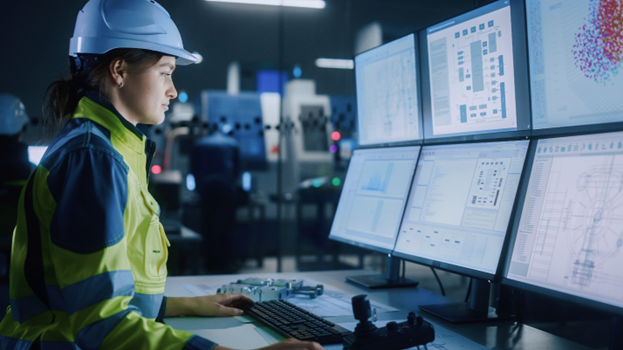
The manufacturing landscape has undergone several transformative revolutions, each marked by groundbreaking technological advancements. These eras, termed Industry 1.0 through Industry 4.0, have progressively shaped global manufacturing, production, and business. As these revolutions evolved, IT and cybersecurity became increasingly crucial, forming the backbone of modern industry and enabling companies to innovate while staying secure.
Industry 1.0: The Birth of Mechanization
The first industrial revolution, or Industry 1.0, began in the late 18th century. It marked the transition from manual labor to mechanization, powered largely by steam engines and water power. Factories became the cornerstone of production, leading to increased output and efficiency. However, in this period, IT and cybersecurity were virtually nonexistent as the concept of digital infrastructure had yet to develop.
The core focus was on mechanical innovation. Yet, even at this early stage, the seeds of modern IT were being planted through the need for better communication and control over machines. Mechanical controls laid the groundwork for the more advanced systems that would come with future industrial revolutions.
Industry 2.0: The Rise of Mass Production and Automation
Industry 2.0 started in the late 19th and early 20th centuries as mass production and assembly lines were introduced, fueled by electricity. It enabled industries to scale operations significantly and produce goods at a much faster rate. Automation began to emerge, albeit in its earliest forms, through simple mechanical systems and conveyor belts.
During this era, early computers, like the punch-card systems, began to make their way into business operations, signaling the first steps toward integrating IT into industry. These systems helped businesses track inventory and manage logistics more efficiently. However, the concept of cybersecurity was still in its infancy, as most systems were isolated and not networked, reducing the risk of external threats.
Industry 3.0: The Digital Revolution and Birth of IT
The digital revolution began in the mid-20th century and was defined by the integration of electronics, computers, and automation. This era saw the birth of the Information Age, where IT systems became integral to manufacturing and business operations. Programmable logic controllers (PLCs), robotics, and early computing systems transformed how factories operated. Businesses could now achieve higher precision, better quality control, and faster production rates.
The rise of networked computers also introduced the need for cybersecurity. As businesses became more reliant on IT/OT systems to store sensitive information and control operations, the risk of cyberattacks and data breaches grew. The need for secure IT infrastructure became apparent, and industries began adopting encryption, firewalls, and antivirus software to protect their systems from unauthorized access.
While technolojoy had not been defined yet, Industry 3.0 was also the birth of using technology to create amazing experiences, performance, and results inside and outside of business.
Industry 4.0: The Smart Factory and Cyber-Physical Systems
The current industrial revolution, Industry 4.0, represents the era of smart factories, where digital and physical systems merge through the Internet of Things (IoT), artificial intelligence (AI), and cloud computing. Factories are becoming fully automated, interconnected, and data-driven, allowing businesses to optimize production in real-time, predict maintenance needs, and enhance efficiency.
At the heart of Industry 4.0 is cyber-physical systems – the integration of physical machines with digital networks. These systems enable machines to communicate with one another and make autonomous decisions, driving unprecedented levels of automation. However, with this increased connectivity comes an even greater emphasis on cybersecurity. As machines, sensors, and software become networked across the globe, they create a larger surface area for cyberattacks. Cybersecurity now plays a critical role in protecting these interconnected systems from potential threats like hacking, ransomware, and industrial espionage. In the modern industrial era, it is more important than ever for manufacturing businesses to ensure they have strong layers of cybersecurity and cyber hygiene.
Industry 4.0 has also brought significant advancements in digital process automation, making it easier to adopt, more cost effective, and highly adaptable when combined with AI. AI has enabled analyzing and understanding of unstructured data such as emails and attachments, which prior to AI required people to manually process this information. By using AI coupled with process automation, this is freeing people to spend more time on value-added work and creating amazing customer/team experiences.
Additionally, the widespread use of cloud computing in Industry 4.0 has elevated the need for data security. Companies are now tasked with securing not only their on-premise systems but also their data stored in the cloud. This requires more sophisticated cybersecurity strategies, including encryption, multi-factor authentication, and constant monitoring for potential threats.
From the mechanization of Industry 1.0 to the interconnected smart factories of Industry 4.0, the role of IT and cybersecurity has grown immensely. As businesses adopt more advanced technologies to stay competitive, robust IT infrastructure and cybersecurity measures will continue to be vital for protecting data, ensuring system integrity, and driving innovation into the future. Each industrial revolution has set the stage for the next, with IT and cybersecurity acting as the fundamental pillars of progress.
TLC Solutions is a business technology provider and we take pride in delivering technolojoy for small and medium businesses in Canada and the US. Beyond IT, TLC Solutions delivers technolojoy with our various solutions including software & automation, cybersecurity, existing IT team support & augmentation, vCIO, hardware/infrastructure upgrades, communication systems, and as your fully outsourced business technology team. We deliver technolojoy!
